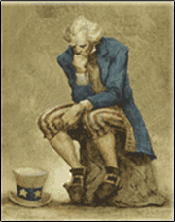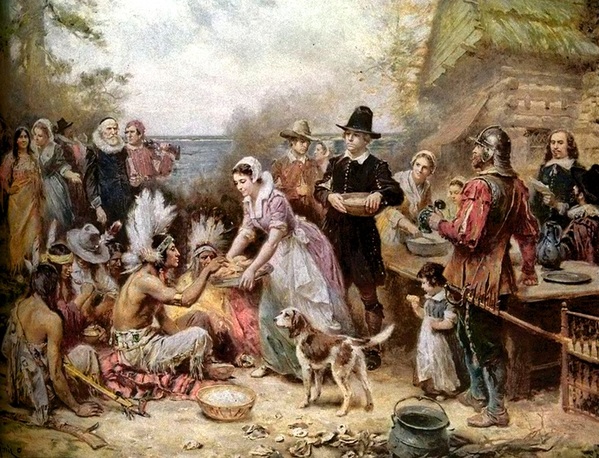
–>
November 24, 2022
On May 14, 1607, headed by a seven-man council that included John Smith, 144 men settled Jamestown. Because of their misguided efforts, it was a disaster from the beginning. These men battled the elements, disease, Indians, starvation, and one another. The lone minister on the adventure, Robert Hunt, did his best to keep the others focused on God. His sermons went mostly unheeded; however, he persevered. By February of 1608 only 38 of the 144 remained alive.
‘); googletag.cmd.push(function () { googletag.display(‘div-gpt-ad-1609268089992-0’); }); }
The death rate did not abate with time. As Peter Marshall and David Manuel note,
For example, of the 1,200 people who went out to Virginia in 1619, only 200 were left alive by 1620. Why this horrible continuing death rate? There is no logical explanation, except one: year after year they steadfastly refused to trust God — or indeed to include Him in any of their deliberations.
The next settlers to cross the Atlantic would not make the same mistakes. They were not seeking wealth and prosperity, but a new home. They believed that America was their spiritual destiny. The Pilgrims (dubbed “Separatists” by the Church of England), and the Puritans who followed them, knew better than to undertake anything without God.
Aboard the Mayflower were 102 passengers, less than half of whom were of Pastor John Robinson’s Separatist flock. After a grueling two-month voyage, on November 11, 1620, they dropped anchor in Cape Cod, and heeding the advice and wisdom of their pastor, the Pilgrims drafted a compact that would embody the same principles of government upon which American democracy would rest. It read,
In the name of God, amen. We whose names are under-written… Having undertaken, for the glory of God and advancement of the Christian Faith and honor of our King and country, a voyage to plant the first colony in the northern parts of Virginia, do by these presents solemnly and mutually in the presence of God and one of another, covenant and combine ourselves together into a civil body politic… constitute and frame such just and equal laws, ordinances, acts, constitutions and offices from time to time, as shall be thought most meet and convenient for the general good of the colony… the 11th of November… Anno Domini 1620.
‘); googletag.cmd.push(function () { googletag.display(‘div-gpt-ad-1609270365559-0’); }); }
Though their efforts were “for the glory of God,” the Pilgrims were not immune to the many hardships of an untamed America. Before long, many started dying. William Bradford’s wife Dorothy was among the casualties as she fell overboard and drowned. (Initially, while dwellings were being built, the Pilgrims lived mostly aboard the Mayflower.) Due in part to a brutal winter, dozens would die in those first few months, including 13 of 18 wives. Despite the hardships, the Pilgrims were undeterred and drew ever closer to God.
The months turned into years and saw the Pilgrims develop good relations with the local natives including Massasoit, a wise and welcoming chief of the local tribes, Samoset, and especially Tisquantum, or Squanto.
Squanto’s life is an amazing tale of God’s provision that closely resembles the account of Joseph from Genesis, chapter 37. Soon after Samoset introduced Squanto to the Pilgrims, a meeting with Massasoit, chief of the Wampanoag people, was arranged. Massasoit, Samoset, Squanto, and dozens of Wampanoag warriors traveled to Plymouth to meet the Pilgrims. With Samoset serving as the interpreter for Massasoit, the meeting was extremely fruitful. A peace treaty and a treaty of mutual aid were struck with Massasoit that would last for decades.
Massasoit and his party returned home, but Squanto remained with the Pilgrims. Being a man without a tribe, personally witnessing the desperation of the Pilgrims, and already having adopted their faith, Squanto took pity upon his new-found English friends and wanted to help them succeed in their New World. He taught them how to fish for eels and alewives, plant corn and pumpkins, refine maple syrup, trap beavers, hunt deer, and other skills essential to their survival.
Squanto was instrumental in the survival of the Pilgrims — so much so that, according to William Bradford, the Pilgrims considered Squanto “a special instrument sent of God for their good, beyond their expectation.” Massasoit also was an amazing example of God’s providential care for the Pilgrims. Like Powhatan had been at Jamestown, Massasoit was probably the only other native chief on the northeast coast of America who would have welcomed the white man as a friend.
The summer of 1621 was beautiful and, thanks in no small measure to the help of Squanto, bountiful. Governor Bradford declared a day of public Thanksgiving to be held in October. Massasoit was invited. Surprising the Pilgrims, he showed up a day early with 90 of his tribe. To feed such a crowd, the Pilgrims would have to go deep into their food supply. However, Massasoit did not show up empty-handed. He had instructed his braves to hunt for the occasion, and they came with several dressed dear and fat turkeys. The Thanksgiving turned into a three-day celebration filled with feasting and games.

‘); googletag.cmd.push(function () { googletag.display(‘div-gpt-ad-1609268078422-0’); }); } if (publir_show_ads) { document.write(“
The winter of 1621-1622 was as difficult as feared. The Pilgrims entered what has been described as their “starving time.” Some reports reveal that at times, food rations for each person were a mere five kernels of corn per day. Miraculously, that winter not one Pilgrim died of starvation.
There was no Thanksgiving celebration in 1622. When the spring planting season of 1623 rolled around, the Pilgrims realized that to fend off further hunger and rationing, a corn harvest at least twice as large as last season was necessary. However, a lackluster work ethic prevailed among them. This was mainly because the contract entered into with their merchant sponsors in London required everything the Pilgrims produced was to go into a common store and be shared. As Rush Limbaugh often pointed out on his radio broadcast that celebrated Thanksgiving Day, the Pilgrims were languishing under socialism.
The leaders of the colony then decreed that for the additional planting, individual plots of land would be split, and the yield could be used at the planters’ discretion. Thus, as the concept of private property was introduced, the Pilgrims seemed infused and invigorated with new hope and purpose. As Marshall and Manuel point out, “The yield that year was so abundant that the Pilgrims ended up with a surplus of corn, which they were able to use in trading that winter with northern Indians, who had not had a good growing season.”
On November 29, 1623, two years after the first Thanksgiving, Governor William Bradford made an official proclamation for a second day of Thanksgiving. In it, Governor Bradford thanked God for their abundant harvest, bountiful game, protection from “the ravages of savages… and disease,” and for the “freedom to worship God according to the dictates of our own conscience.” Well over a hundred Natives attended, bringing plenty of turkey and venison along with them.
The Pilgrims, and the Puritans who followed them, had the proper perspective. As Bradford would so discernibly note, “As one small candle may light a thousand, so the light kindled here has shown unto many, yea in some sort to our whole nation… We have noted these things so that you might see their worth and not negligently lose what your fathers have obtained with so much hardship.”
May the light of those first Thanksgivings never be extinguished.
Trevor Grant Thomas
At the Intersection of Politics, Science, Faith, and Reason.
Trevor is the author of The Miracle and Magnificence of America
Image: Gérôme
<!– if(page_width_onload <= 479) { document.write("
“); googletag.cmd.push(function() { googletag.display(‘div-gpt-ad-1345489840937-4’); }); } –> If you experience technical problems, please write to [email protected]
FOLLOW US ON
<!–
–>
<!– _qoptions={ qacct:”p-9bKF-NgTuSFM6″ }; ![]() –> <!—-> <!– var addthis_share = { email_template: “new_template” } –>
–> <!—-> <!– var addthis_share = { email_template: “new_template” } –>




